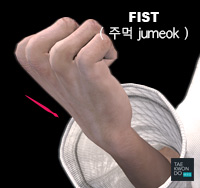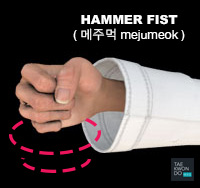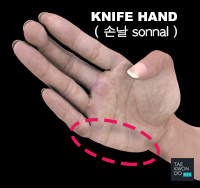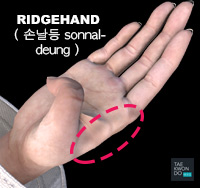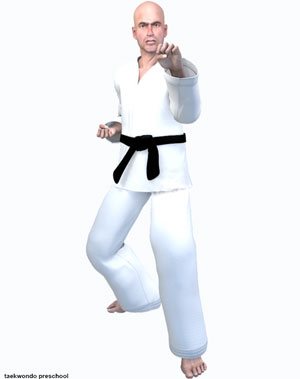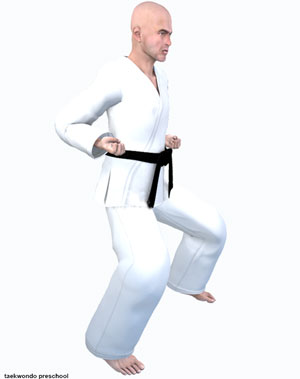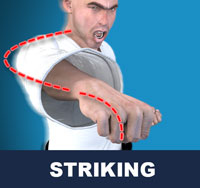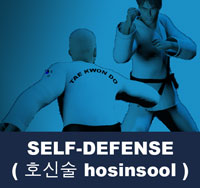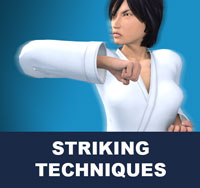Taekwondo 태권도Taekwondo Preschool
When you reach senior belt you are expected to guide the junior belts when they are beginning Taekwondo such as showing by example. To advance from one rank to the next, students typically complete promotion tests in which they demonstrate their proficiency in the various aspects of the art before a panel of judges or their teacher. View Taekwondo belt levels »

Classifications of Breaks
Breaking ( 격파 gyeokpa ) is the discipline of destroying inanimate materials such as wooden boards, bats, ice or bricks is a feature common to several Asian martial arts including taekwondo. In breaking competitions, the idea is to demonstrate power, speed and technique. The preferred object is commonly wooden boards of varying thicknesses, advanced students break several boards stacked one on top of the other.
There are generally 3 classifications of breaks: speed breaks, power breaks, and soft breaks. There is a 4th, lesser-known, classification known as the impulse break.

Training Safety Precautions
There are safety concerns with taekwondo breaking ( 격파 gyeokpa ), so one should seek out a certified Master Instructor ( 사범님 sabeomnim ). There are many small bones of the foot ( 발 bal ) and hand ( 손 son ) which need to be very carefully and slowly conditioned for safety. Repeated damage to the extensor capsules of the knuckles can lead to long term problems with dexterity.
* Please see a certified Master Instructor ( 사범님 sabeomnim ) for training. Proper guidance and instructions are needed to ensure safe training.
Speed Break
Speed breaks are breaks where the striking object is not held in place. The only way to break the object is to strike the surface with sufficient speed at a focused point of impact. Sometimes a board to be broken is held lightly between two fingers by a person; an advanced black belt ( 단 dan ) test may involve an attempt to break a board as it falls through the air. Regardless of the strength of the taekwondo practitioner, the board will only break if it is struck with sufficient velocity.
Examples of Speed Break
- Jumping Back Whip Kick ( 뛰어 뒤후려차기 ttwieo-dwi-huryeo-chagi )
- Jumping Flip Kick ( 공중제비차기 gongjungjebi-chagi )
- Jump Two-Foot Front Kick ( 뛰어 두발 앞차기 ttwieo-dubal-ap-chagi )
Another type of "Speed Break" is that which involves breaking a number of objects over a given amount of time. A common time span is 1 minute, but this can vary depending on the material and venue. In competition it is very common for a speed breaking category to limit the time to 8–10 seconds, enabling more taekwondo competitors to participate. Records and specifics are kept track of by leading martial arts breaking organizations such as the USBA/WBA (United States and World Breaking Associations).

Power Break
Power breaks are breaks where the striking object is supported. Either the break will employ human holders for horizontal, angular, or upward vertical strikes, or the break will require that the objects be stacked for downward vertical strikes. For a stacked break the object is placed on sturdy supporting objects, such as concrete blocks, that are placed on the ground.
Many color belt ( 급 geup ) ranking (before black belt) promotion tests have power breaks - it is substantially easier for an inexperienced person to muster sufficient energy to break a wooden board with a power break. The vast majority of these employ human board holders. Often a stronger or more powerful striker may substitute some strength for technique and successfully accomplish the break. Most records that are catalogued are for power breaks. It is very common for black belt ( 단 dan ) promotion tests to use concrete bricks, ice blocks, or several boards stacked on top of supporting objects for challenging downward strikes.
Examples of Power Break
Taped boards are sometimes used to lessen the amount of human influence from the holders for a break. It is very difficult to hold a stack of boards more than 4 inches steadily enough for the challenging break. Therefore, some taekwondo strikers will tape a stack of boards together to make a "brick" for their holders to hold. Usually however, breaks at promotion tests and events are done without taped boards.
Both the speed and power breaks deliver the energy required to overcome the tensor and flexion forces of the board through mass displacement, where the kinetic energy is given by 1/2 m*v2. That is, either the speed of the striking implement (hand/foot/etc) has to be high enough, or the striker must be strong enough to increase effective mass brought into the break (i.e. his or her body weight) to exceed the brick/board's threshold. For single boards, it is generally easy (as in the casual person has a sufficient reserve of mass) to reach this threshold through a power break.
Soft Break
The third method, soft breaks, also known as "ki" breaks involve the use of palm heel ( 바탕손 batangson ) strikes only. The material is usually supported, horizontally, on two ends. The breaker raises their hand ( 손 son ) and lets the palm strike fall, by the use of gravity alone and no muscle power, onto the material. The material is broken by energy transfer all the way through, in a direct line from the palm to the material. It is also through a wider area of impact and usually causes more damage than other strikes.
Examples of Soft Break
This break is akin to striking a person with a slap. A palm heel ( 바탕손 batangson ) strike can cause much more internal damage while a punch, or similar strike, causes more external damage. Also, a soft strike may leave a red mark while most impact strikes leave more. Any person of any age, such as elderly people up to 80 and 90 years of age, can do this break and never seriously injure themselves. The most serious injury may be a palm ( 손바닥 sonbadak ) that tingles if the break is not successful. Breaks of more than one piece of material, done with no spacers, with this method are also attainable by people of any age or gender.
Impulse Break
Though fundamentally different, the 4th kind of break — the impulse break — is often confused with a speed break, because the striking implement can (but need not) reach a high speed. But that is where the similarity ends. The energy transmission from an impulse break derives not from mass displacement, but from wave transmission (as an ocean wave hits a beach). The mass of the hand/foot/etc does not travel much further than necessary to deliver the wave—this results in an extremely brief contact with the brick or board face (as opposed to going "through it"), and the wave itself causes the striking surface to flex and buckle. The less flexible the striking surface, the more likely to break.
* Please see a certified Master Instructor ( 사범님 sabeomnim ) for training. Proper guidance and instructions are needed to ensure safe training.

Related Articles
Breaking ( 격파 gyeokpa ) is the discipline of destroying inanimate objects such as wooden boards, bats, ice or cement bricks. The preferred object is commonly wooden boards of varying thicknesses, advanced students break several boards stacked one on top of the other. View Breaking ( 격파 gyeokpa ) »
Risk of injury can be reduced by completing an effective warm up consisting of a heart raiser to get your pulse up, followed by sport specific dynamic stretches (stretches whilst moving). Please follow the guidance of a certified Master Instructor or trainer when doing sports related activities. Depending on the intensity of the exercise, cooling down can involve a slow jog or walk, or with lower intensities, stretching can be used. Cooling down allows the heart rate to return to its resting rate. View more information on Warming Up and Cooling Down ».
This article uses material from the Wikipedia articles "Warming Up" and "Cooling Down", which is released under the Creative Commons Attribution-Share-Alike License 3.0.
RESOURCES
This article uses material from the Wikipedia article "Breaking (Martial Arts)" which is released under the Creative Commons Attribution-Share-Alike License 3.0.



